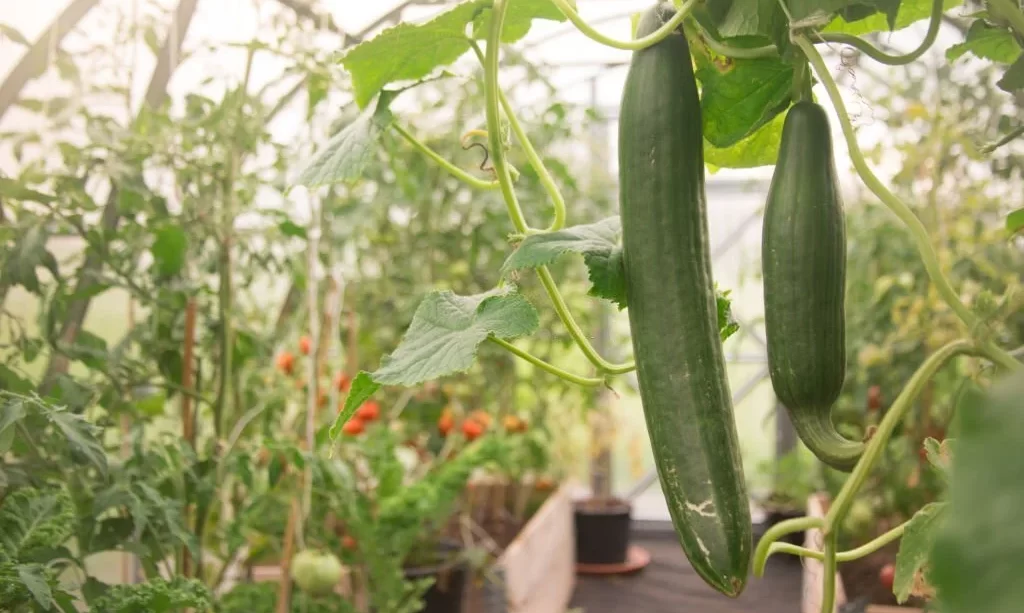Cucumbers, with their crisp texture and refreshing taste, are a beloved addition to many gardeners’ plots. Whether destined for salads, pickles, or simply as a healthy snack, these green gems have a well-deserved place in our gardens and kitchens. Yet, in the pursuit of growing the finest cucumbers, there’s a secret that seasoned gardeners have long known – the art of companion planting.
Companion planting is a gardening strategy that involves strategically pairing certain plants together to achieve mutual benefits. In the world of cucumbers, this technique can be a game-changer, unlocking a realm of advantages that go beyond what a solitary cucumber plant can offer.
- Cucumis Sativus: These finest quality, non-GMO, USDA Organic Marketmore Cucumber seeds produce hefty dark green, smooth fruits 8-9 inches long with a sweet and mild flavor ideal for slicing, salads, sandwiches and soups.
- Benefits of Trellising: When growing cucumber vines a trellis will encourage the vines to climb, which helps protect the fruit from damage, and help maximize space in smaller gardens.
- Freshly Packed: These seeds are packed for the current growing season and will provide high germination rates next year as well.
- Certified Organic: All Purely Organic Seeds are open pollinated, non-GMO (not genetically modified), heirloom, organic seeds. Each Purely Organic Seed Packet carries the USDA Organic Seal signifying that is has passed rigorous standards and been certified organic by a USDA Accredited agency.
- Premium Packaging: All seeds from Purely Organic Products are packaged in individually styled packets ideal for gifts, storage or immediate use. Each packet displays the plant variety on the front with instructions and plant facts on the back.
The Benefits of Companion Planting with Cucumbers
Companion planting with cucumbers isn’t merely a gardening tradition; it’s a practice steeped in wisdom and proven benefits:
- Pest Control: One of the primary advantages of companion planting is pest control. By selecting specific companion plants, you can deter common cucumber pests like aphids, cucumber beetles, and spider mites. These companions release natural chemicals or scents that discourage harmful insects from settling near your cucumber plants.
- Enhanced Pollination: Cucumbers, like many other vegetables, rely on pollinators for fruit production. Companion plants such as flowers attract pollinators like bees and butterflies, increasing the likelihood of successful pollination. This, in turn, leads to higher cucumber yields and improved fruit quality.
- Soil Health: Certain companion plants, when interplanted with cucumbers, contribute to soil health. They help fix nitrogen in the soil, improve soil structure, and suppress weeds, creating a more fertile and balanced growing environment for your cucumbers.
- Biodiversity and Balance: Companion planting fosters biodiversity in your garden, creating a balanced ecosystem that benefits all plants involved. By diversifying your garden with different species, you reduce the risk of plant diseases and soil depletion.
As we delve deeper into the world of companion planting with cucumbers, you’ll discover a wealth of possibilities and plant combinations that can elevate your garden’s health and productivity. By harnessing the power of these natural partnerships, you’ll cultivate a more resilient and fruitful cucumber patch, unlocking the full potential of your garden’s bounty.
Companion Plants for Cucumbers
Selecting the right companion plants to grow alongside cucumbers is a thoughtful and strategic choice. Here are some plant partners that work harmoniously with cucumbers:
- Beans and Peas: Legumes like beans and peas are excellent companions for cucumbers. They belong to the same plant family, Leguminosae, which means they have similar soil and nutrient requirements. Additionally, legumes are nitrogen-fixing plants, enriching the soil with this essential nutrient, benefiting your cucumber plants.
- Radishes: Radishes serve as a natural pest deterrent for cucumbers. Their pungent scent repels cucumber beetles, a common cucumber pest. Interplanting radishes between your cucumber rows can help protect your cucumber plants from these harmful insects.
- Dill: Dill is not only a flavorful herb but also a beneficial companion for cucumbers. Its aromatic foliage attracts beneficial insects like ladybugs and parasitic wasps, which prey on cucumber pests. Planting dill near cucumbers can help keep destructive insects in check.
- Nasturtiums: Nasturtiums are not only visually striking with their vibrant flowers but also highly functional companions for cucumbers. They deter aphids and whiteflies, two common cucumber foes, with their peppery scent. Additionally, nasturtium flowers are edible and can be a delightful addition to your culinary repertoire.
Flowers as Cucumber Companions
Flowers play a pivotal role in companion planting with cucumbers, adding beauty and functionality to your garden:
- Marigolds: Marigolds are renowned for their pest-repelling qualities. They emit a scent that deters aphids, nematodes, and other harmful insects that often trouble cucumbers. Planting marigolds as a border around your cucumber patch can create a protective barrier.
- Nasturtiums: As mentioned earlier, nasturtiums are not only attractive but also effective at deterring aphids and whiteflies, making them ideal companions for cucumbers.
- Calendula: Calendula, with its cheerful orange and yellow flowers, attracts pollinators like bees and butterflies. These pollinators play a crucial role in cucumber fruit development. By planting calendula near your cucumber plants, you encourage increased pollination and higher yields.
- Lavender: Lavender’s aromatic blooms are not only a delight to the senses but also a magnet for pollinators. Bees are particularly drawn to lavender, enhancing pollination in your cucumber patch.
These flowers serve as both functional and decorative companions, contributing to the health and vitality of your cucumber garden while adding a burst of color and fragrance to your outdoor space. As you plan your cucumber garden, consider the harmonious partnerships that can be forged with these plant allies to create a thriving and visually appealing oasis.
- Calendula Flowers
- 100% Organic
- No Pesticides / Non-Irradiated
- Botancial Name: calendula officinalis
- Harvested in Egypt
Vegetables and Herbs as Cucumber Companions
In the world of companion planting, vegetables and herbs can be valuable allies for cucumbers:
- Lettuce: Planting lettuce near cucumbers provides natural shade and helps keep the soil cool. Cucumbers appreciate the slightly cooler microclimate created by the lettuce leaves. Plus, you’ll have fresh salad ingredients right at your fingertips.
- Corn: Corn can serve as a living trellis for cucumbers to climb. This vertical gardening technique optimizes space and sunlight in your garden. Cucumbers benefit from the support and can access more sunlight while corn grows tall.
- Borage: Borage is an herb that cucumbers appreciate as a companion. Its attractive blue flowers attract pollinators like bees, ensuring efficient cucumber pollination. Additionally, borage leaves can be used as a beneficial mulch.
- Oregano and Basil: Herbs like oregano and basil can enhance cucumber flavor and provide natural pest protection. Their aromatic qualities can deter certain cucumber pests, making them suitable neighbors.
- Quality Borage seeds packaged by Seed Needs. Intended for the current and the following growing season. Packets are 3.25″ wide by 4.50″ tall and come with a full colored illustration on the front side, as well as detailed sowing instructions on the reverse.
- Both Borage seed packets will contain 100 seeds each, for a combined total of 200 seeds.
- Borage is an annual herb that is primarily grown for it’s odd, yet beautiful flowers. Both the Blue and White variety of Borage are edible.
- Borage flowers can be added to salads for an extra splash of color. The plants can begin to be harvested in roughly 50 to 60 days.
- All Borage seeds sold by Seed Needs are Non-GMO based seed products and are intended for the current & the following growing season. All seeds are produced from open pollinated plants, stored in a temperature controlled facility and constantly moved out due to popularity.
Companion Planting Strategies
Successful companion planting requires thoughtful planning and strategic garden design:
- Interplanting: Plant companion species directly among your cucumber rows or around the cucumber patch. This proximity maximizes the benefits of companion planting.
- Companion Planting Guilds: Create companion planting guilds by selecting a combination of plants that work well together. For cucumbers, a guild might include beans, radishes, marigolds, and dill. These plants complement each other and offer various benefits.
- Crop Rotation: Implement a crop rotation strategy to prevent soil depletion and pest buildup. Avoid planting cucumbers or their companions in the same spot year after year to maintain soil health.
- Observation and Adaptation: Continuously observe your garden and make adjustments based on how well your companion plants are performing. Not all combinations may work as expected, so be prepared to adapt and experiment.
Conclusion
Companion planting with cucumbers is not just a gardening technique; it’s a holistic approach to cultivating a thriving and balanced garden ecosystem. By strategically selecting companion plants from a diverse range of flowers, vegetables, and herbs, you can enhance the health and productivity of your cucumber patch.
The benefits of companion planting extend far beyond pest control and increased yields. They create a vibrant and harmonious garden where each plant plays a vital role in supporting the others. As you explore different companion planting strategies, you’ll not only enjoy a more bountiful cucumber harvest but also experience the beauty and synergy of a garden that mirrors the intricate relationships found in the natural world.
So, as you plan your next cucumber garden, consider the companions that can enrich your growing experience and transform your garden into a thriving, interconnected ecosystem. With each planting decision, you contribute to the art and science of companion planting, creating a more sustainable and abundant garden for seasons to come.







